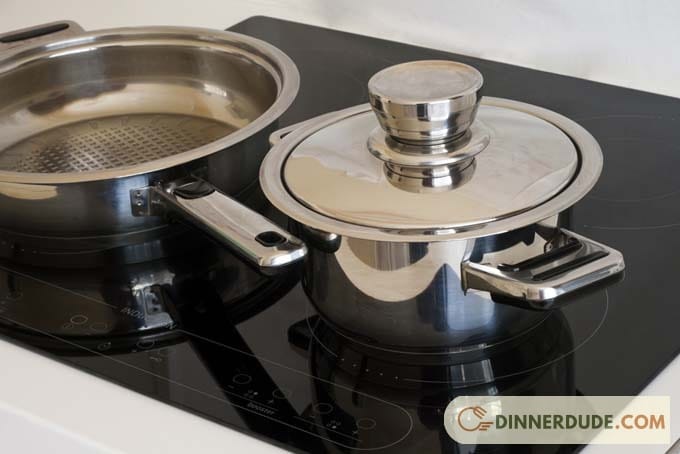Induction cookware is a popular choice among cooking enthusiasts and professional chefs alike for its efficiency, speed, and precision.
But one common question is: Can induction cookware go in the oven? Let’s learn interesting information through the article below provided by Dinnerdude
Characteristics of Induction Cookware

Understanding Induction Cookware
Induction cookware stands out for its distinctive magnetic base, a crucial feature that renders it compatible with induction stovetops. The unique mechanism lies in the induction stovetop’s ability to generate heat directly within the pot or pan, accomplished through the creation of a magnetic field. This innovative cooking technology mandates that the cookware be crafted from materials possessing magnetic reactivity, such as cast iron or stainless steel. This ensures a seamless and efficient transfer of heat, making induction cookware an indispensable choice for those seeking precision and energy efficiency in their culinary endeavors.
Construction and Material of Induction Cookware
Sure. The only thing that prevents using induction cookware in an oven is the material used for the handle.
Most cookware handles can withstand temperatures of at least 400 degrees Fahrenheit, if not higher. Otherwise, the pan’s material is more than capable of withstanding the heat of a standard home oven.
The construction and material of the cookware are pivotal elements when it comes to its compatibility with different heat sources. As induction cookware is typically made from materials like stainless steel or cast iron, they are often highly resistant to heat.
These materials are also known to withstand high temperatures, which makes them potentially suitable for oven use.
Can induction cookware go in the oven?

Indication of Oven-Safety
The oven compatibility of induction cookware is predominantly contingent on its design and the composition of materials incorporated into its handles and lids.
Typically, manufacturers provide explicit information regarding the oven suitability of their cookware through labeling on the packaging or inclusion in the product description. Verifying this crucial detail becomes paramount before deciding to place any cookware in the oven.
As such, conscientious consumers are advised to scrutinize these specifications to ensure that the cookware aligns with their intended usage, promoting both the longevity of the product and the safety of the cooking process. By adhering to these guidelines, individuals can make informed decisions about the dual functionality of their induction cookware, confidently navigating its usage both on stovetops and in ovens.
Precautions When Using Induction Cookware in the Oven
While induction cookware labeled as oven-safe provides a versatile cooking option, it’s essential to observe certain precautions to maintain the safety and integrity of the cookware.
Firstly, it is imperative to adhere to the maximum temperature limit specified by the manufacturer. Exceeding this threshold may compromise the structural integrity of the cookware, leading to potential damage.
Additionally, if the cookware features plastic handles or components, it is generally unsuitable for oven use. The vulnerability of plastic to high temperatures could result in deformation or melting, posing a safety hazard. Similarly, when utilizing cookware with a lid in the oven, it’s crucial to verify the lid’s oven safety to prevent any unintended damage.
By exercising diligence and attentiveness to these guidelines, users can maximize the utility of their induction cookware in the oven while prioritizing safety and longevity.
Making Use of Your Induction Oven-Safe Cookware

Instead of using oven mitts to hold hot pans and pots, use a dry kitchen towel. Fold it twice and wrap it around your hand for a secure grip. Professional chefs handle their cookware in this manner because it is more convenient than using oven mitts.
Preheating the oven is recommended in many recipes. To avoid warping, place your pot or pan in the oven while it is still cold and allow it to heat up with the oven.
This avoids putting cold cookware into a preheated oven. To avoid losing too much heat, once the oven is hot, you must quickly open the oven door and add your food to the (hot) pot or pan.
After you remove the pot or pan from the heat, do not place it on a cold surface, such as a stone countertop or wooden cutting board, as this can cause it to warp. Instead, place it on a cooling rack and allow it to cool down gradually.
Pouring cold water over a hot pot or pan is also dangerous for the same reasons. A “thermal shock,” or sudden temperature change, can cause it to warp almost instantly.

In conclusion, while induction cookware can generally be used in an oven due to its robust material construction, it’s still vital to check product specifications and manufacturer guidelines to ensure safety and longevity of your cookware.